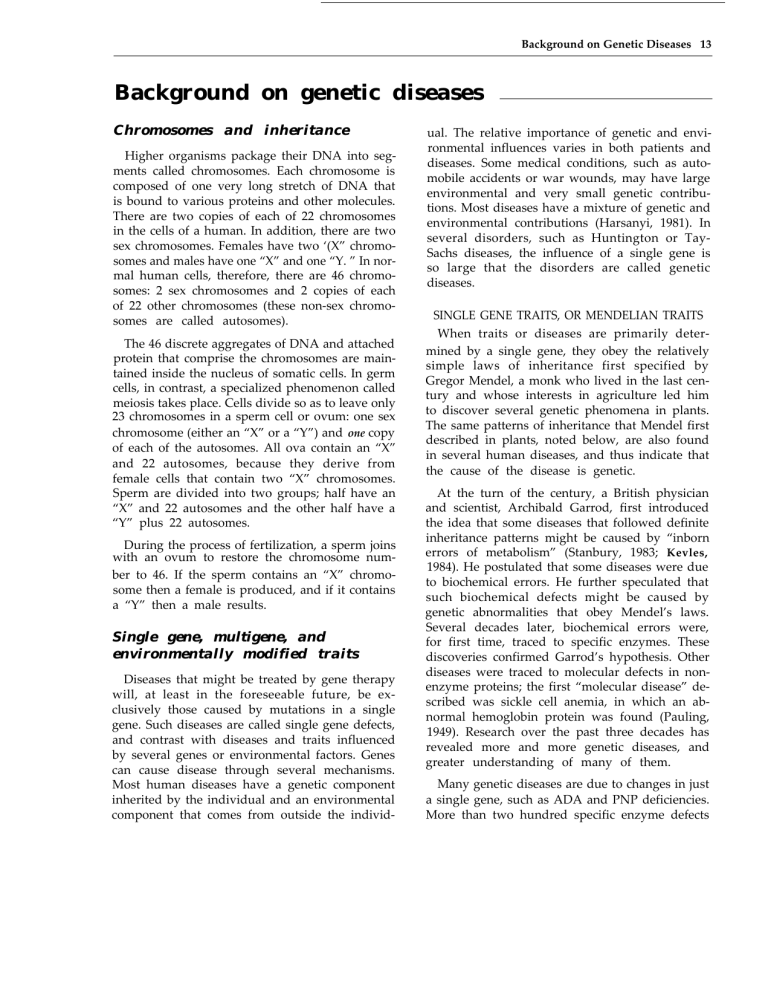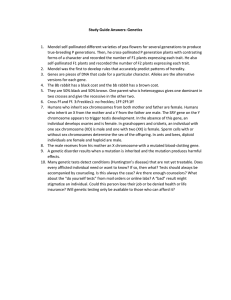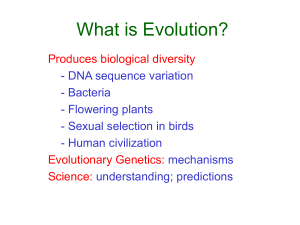Background on genetic diseases Chromosomes and inheritance
advertisement

Background on Genetic Diseases 13 Background on genetic diseases Chromosomes and inheritance Higher organisms package their DNA into segments called chromosomes. Each chromosome is composed of one very long stretch of DNA that is bound to various proteins and other molecules. There are two copies of each of 22 chromosomes in the cells of a human. In addition, there are two sex chromosomes. Females have two ‘(X” chromosomes and males have one “X” and one “Y. ” In normal human cells, therefore, there are 46 chromosomes: 2 sex chromosomes and 2 copies of each of 22 other chromosomes (these non-sex chromosomes are called autosomes). The 46 discrete aggregates of DNA and attached protein that comprise the chromosomes are maintained inside the nucleus of somatic cells. In germ cells, in contrast, a specialized phenomenon called meiosis takes place. Cells divide so as to leave only 23 chromosomes in a sperm cell or ovum: one sex chromosome (either an “X” or a “Y”) and one copy of each of the autosomes. All ova contain an “X” and 22 autosomes, because they derive from female cells that contain two “X” chromosomes. Sperm are divided into two groups; half have an “X” and 22 autosomes and the other half have a “Y” plus 22 autosomes. During the process of fertilization, a sperm joins with an ovum to restore the chromosome number to 46. If the sperm contains an “X” chromosome then a female is produced, and if it contains a “Y” then a male results. Single gene, multigene, and environmentally modified traits Diseases that might be treated by gene therapy will, at least in the foreseeable future, be exclusively those caused by mutations in a single gene. Such diseases are called single gene defects, and contrast with diseases and traits influenced by several genes or environmental factors. Genes can cause disease through several mechanisms. Most human diseases have a genetic component inherited by the individual and an environmental component that comes from outside the individ- ual. The relative importance of genetic and environmental influences varies in both patients and diseases. Some medical conditions, such as automobile accidents or war wounds, may have large environmental and very small genetic contributions. Most diseases have a mixture of genetic and environmental contributions (Harsanyi, 1981). In several disorders, such as Huntington or TaySachs diseases, the influence of a single gene is so large that the disorders are called genetic diseases. SINGLE GENE TRAITS, OR MENDELIAN TRAITS When traits or diseases are primarily determined by a single gene, they obey the relatively simple laws of inheritance first specified by Gregor Mendel, a monk who lived in the last century and whose interests in agriculture led him to discover several genetic phenomena in plants. The same patterns of inheritance that Mendel first described in plants, noted below, are also found in several human diseases, and thus indicate that the cause of the disease is genetic. At the turn of the century, a British physician and scientist, Archibald Garrod, first introduced the idea that some diseases that followed definite inheritance patterns might be caused by “inborn errors of metabolism” (Stanbury, 1983; Kevles, 1984). He postulated that some diseases were due to biochemical errors. He further speculated that such biochemical defects might be caused by genetic abnormalities that obey Mendel’s laws. Several decades later, biochemical errors were, for first time, traced to specific enzymes. These discoveries confirmed Garrod’s hypothesis. Other diseases were traced to molecular defects in nonenzyme proteins; the first “molecular disease” described was sickle cell anemia, in which an abnormal hemoglobin protein was found (Pauling, 1949). Research over the past three decades has revealed more and more genetic diseases, and greater understanding of many of them. Many genetic diseases are due to changes in just a single gene, such as ADA and PNP deficiencies. More than two hundred specific enzyme defects 14 • Human Gene Therapy—Background Paper cause known human clinical syndromes, and over a hundred other genetic diseases have been biochemically characterized (Stanbury, 1983). Prominent disorders such as sickle cell anemia, familial hypercholesterolemia, polycystic kidney disease, Huntington disease, neurofibromatosis, Duchenne muscular dystrophy, cystic fibrosis, achondroplasia, hemophilia, and many others are examples of single gene disorders. Many common adult disorders, usually excluded from pediatric statistics on genetic disease prevalence, such as Alzheimer disease and hemochromatosis, have forms strongly influenced by genetics (Breitner, 1984; Cook, 1979, 1981; Folstein, 1981; Cartwright, 1978, Dadone, 1982; Skolnick, 1982; Kravitz, 1979). Single gene defects affect 1 to 2 percent of newborns (Lubs, 1977), and addition of adult genetic diseases would significantly increase the estimated prevalence and cost of genetic disease. Even diseases or traits that are due to a single gene vary widely in severity, depending on environmental factors and other genes; the extent to which patients have signs and symptoms of a genetic disease is called “expressivity.” Diseases can also be variably expressed in populations, affecting some people and not others who carry the gene. This is described as “penetrance.” Complete penetrance indicates that all who have the defective gene also have the disease, while incomplete penetrance means that some people have the gene but not the disease. Single gene traits can be classified by how they are inherited. They can be recessive, dominant, or X-linked. Recessive Disorders.--Recessive diseases occur when one receives a defective gene from both parents (see diagram). Diseases due to dysfunctional gene pairs are usually due to protein abnormalities that cause a biochemical imbalance. Sickle cell disease and thalassemia affect globin, the protein part of hemoglobin, which transports oxygen through the blood to body tissues. Other recessive disorders, such as Tay-Sachs disease, ADA and PNP deficiencies, and phenylketonuria (PKU), affect enzymes whose absence or dysfunction adversely affects cellular metabolism. Most of the relatively well understood genetic diseases are recessive disorders that can be traced to spe- Recessive Inheritance Mother Father Non-carrier 25% Carrier 5 0 % Child with disease 25% Chromosome with normal gene Chromosome with defective gene SOURCE: Office of Technology Assessment. cific defects in enzymes. However, the specific molecular defect underlying many recessive diseases, including at least one common one-cystic fibrosis—is not known, Dominant Disorders.--Dominant disorders occur when offspring receive a defective gene from either parent, and having just one such gene leads to expression of the disease (see diagram). In some cases the defect is known, such as some types of porphyria, in which enzyme deficiencies lead to abnormal disruption of biochemical pathways that produce and degrade heme—the non-protein part of hemoglobin found in red blood cells. In most dominant disorders, however, the biochemical nature of the derangement is not known; the molecular defect in dominant disorders is, in general, less well established than for recessive ones. X= Linked Disorders.—X-linked disorders are carried on the “X” chromosome. X-linked diseases usually affect boys because males have only one copy of the “X” chromosome: there is no set of genes on a second “X” chromosome to balance the effects of a defective copy of the gene. The inheritance pattern of X-linked disorders is distinc- Background on Genetic Diseases . 15 Dominant Inheritance Unaffected parent Affected parent from the mother in boys, and are usually recessive in girls. Examples of X-linked disease traits are hemophilia, Duchenne muscular dystrophy, and Lesch-Nyhan syndrome. There are apparently few traits, and no known diseases, that are carried in genes located on the “Y” chromosome, and expressed only in males. Single gene defects are, in general, the best understood of genetic diseases; the early instances of human gene therapy will be done to correct the effects of single mutant genes. MULTIGENE TRAITS Unaffected chiId 50% There are certain body characteristics and other traits that accrue from the interactions of several genes. Eye and hair color, for example, are traits that are specified by genes, but do not obey simple Mendelian patterns of inheritance because many genes are involved. Similarly, there are genetic diseases caused by interactions of multiple genes that are minimally affected by environmental influences. Such disorders are termed polygenic or multigenic. Affected child 50% Chromosome with normal gene Chromosome with defective gene SOURCE Off Ice of Technology Assessment. X-Linked Inheritance Mother (carrier) Non-carrier Affected Carrier son daughter daughter NOTE: x—Normal chromosome. @ –Chromosome with abnormal gene. Father (unaffected) Unaffected son SOURCE” Off Ice of Technology Assessment tive: sons inherit the traits only from their mothers, because a son always derives his “X” from his mother and his “Y” from his father. Daughters can get a defective gene from either parent, but do not usually have the disease unless they get the abnormal gene from both parents. X-linked traits thus act like dominant traits inherited only ENVIRONMENTALLY MODIFIED TRAITS The vast majority of characteristics that define individuals are determined by a combination of genetic predisposition and interaction with the environment. Height, for example, though determined genetically to a significant extent, is also influenced by nutrition and other factors. Likewise, many diseases derive from interactions of genes and the environment in which both components contribute significantly to the disease process. The type of diabetes mellitus that occurs in younger people, for example, is now believed to be caused by a special susceptibility of insulinsecreting cells to certain viral infections or other environmental insults. The clinical disorder is thus caused by an environmental agent acting in concert with genetic characteristics. Most common diseases, including cardiovascular diseases, cancer, and many drug reactions appear to involve multiple genes as well as environmental influences. Most complex human traits, including physical and intellectual capacities, are also multigenic and 16 Human Gene Therapy—Background Paper environmentally influenced. The controversies that have raged in the psychological literature over the genetic and racial components of intelligence center on the relative importance of genetic and environmental contributions, including nutrition, health care, cultural background, and socioeconomic status. There is little doubt that genetics and environment interact, but there is vigorous contention about which factor predominates and how public policy should respond to differences in complex traits such as intelligence, Genetic treatment versus eugenics Eugenics is the term applied to “the ‘science’ of improving human stock by giving ‘the more suitable races or strains of blood a better chance of prevailing speedily over the less suitable’ “ (Kevles, 1984, quoting Francis Galton). The eugenics movement is noted for promulgating social programs intended to enhance desired human traits, such as intelligence and physical strength, and to eliminate undesirable traits, such as “feeblemindedness)” criminality, and disease. Germs of eugenic thought persist in contemporary society, notably in regard to controversies about genetics and intelligence (Lewontin, 1984), and some fear that the technical advances of molecular genetics may lend themselves to abuse (Grobstein, 1984; Reilly, 1977). This is not a criticism of the technology per se, but rather a concern about its potential misapplication or affiliation with forms of social coercion (Powledge, 1984). The distinction between gene therapy and eugenics rests on several different points. Gene therapy involves the informed participation of patients who suffer from a specific disease, while eugenics involves social programs, sometimes involuntary ones, focused on general human traits. Gene therapy is intended to benefit a particular individual, while eugenics is intended to improve the human general (or, often, national) population. Gene therapy is directed at correction of symptoms due to genes known to cause disease, while eugenics often dwells on polygenic traits whose genetic components are controversial, and whose expression is poorly understood. Eugenic social movements date back to the last century, and the intellectual history of eugenics extends much further back in history (Kevles, 1984). Deliberate eugenic interventions have been decried several times in the 20th century. Eugenic movements were popular throughout Europe and the United States early in this century, and were most overtly expressed by the National Socialist (Nazi) Party in Germany before and during World War II. Medical, scientific, technical, ethical, religious, and social commentators have noted the difference between therapy for a specific genetic disease and interventions intended to enhance traits such as intelligence and physical appearance (Siegel, 1982,1983; Fletcher, 1983b; Friedmann, 1983). Genetic correction of specific diseases, if it does not affect the germ line, is analogous to other medical procedures that involve risk assessment by the patient and attending health professionals. Federal legislation to restrict immigration passed between World Wars I and II was based, in part, on eugenic principles, and mandatory sterilization laws also supported by eugenicists still exist in several States (Kevles, 1984; Reilly, 1977) and are occasionally used (Bowman, 1984). Many prominent geneticists were involved in the American eugenics movement in the early part of this century (Kevles, 1984), and participated as “experts” in preparing legislation or otherwise promulgating social reform congruent with eugenic aspirations. There is not a complete dichotomy, however, between the correction of specific diseases and eugenics based on social preferences for certain traits. This is relevant in considering gene therapy because it vitiates any sharp distinction between correction of a specific genetic defect, which might be treated by gene therapy, and affecting a mildly undesirable trait, for which gene therapy might be controversial. A genetic condition might be considered serious by one person, and not by someone else. Baldness or brown eyes, for example, might be considered treatable









